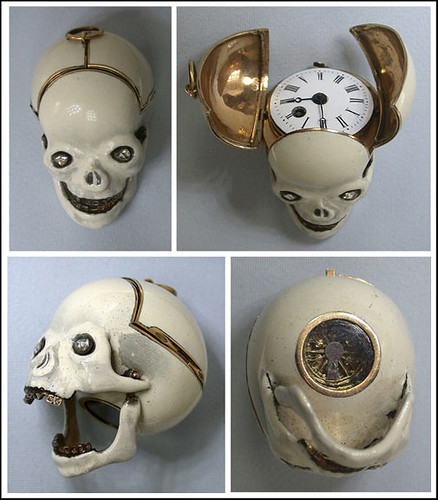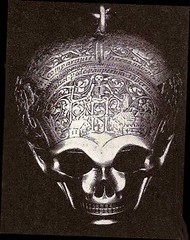I've been a little under the weather recently, but I am starting out the new year with a new post. Happy New Year to all the folks on line.
CoastConFan
A fannish blog dedicated to Science Fiction and Fantasy conventions, movies, games, game design, costuming, prop making, blogs, horror, steampunk, RPGs, Tintin, H. P. Lovecraft, Cthulhu, books, videos, and to CoastCon itself. CoastCon is a SF & F convention that has been held annually in Biloxi, Mississippi each Spring for nearly 40 years.
Saturday, December 31, 2011
Happy New Year 2011 - 2012
Monday, December 5, 2011
Run! Here Come the Firemen!
A 21st century electronic Fahrenheit 451 slowly becomes reality.
Let’s get this straight, I think that e-books are a good thing and frankly, I think Project Gutenberg is an absolutely wonderful treasure trove of copyright free books. Electronic format books are here to stay and they have some great contributions to make to society.
 However, the publishing industry has found that e-books are cheaper than paper and by golly you are going to have them, whether you want them or not. The main problem I have with e-books is their plasticity and vulnerability of flash editing. I am reminded of the book, Brave New World, with political leaders constantly changing positions and making people believe it’s always been that way. With present and emerging technology e-book burnings are just a click away – eat your hearts out 20th century dictators, using old fashioned bonfires.
However, the publishing industry has found that e-books are cheaper than paper and by golly you are going to have them, whether you want them or not. The main problem I have with e-books is their plasticity and vulnerability of flash editing. I am reminded of the book, Brave New World, with political leaders constantly changing positions and making people believe it’s always been that way. With present and emerging technology e-book burnings are just a click away – eat your hearts out 20th century dictators, using old fashioned bonfires.
Reading has always been revolutionary and magical. Johannes Gutenberg didn’t invent the printing press and not even moveable type in the 15th century, but he did make printing books and easier to use. The drop in book prices over the next century allowed well-to-do literate people to own books and then even upper middle class folks to have books. This all trickled down over the centuries to the Victorian dime novels and pennydreadfuls that allowed even the poor access to books (let’s not get into literary quality here).
Recently, Ray Bradbury, Science Fiction author extraordinaire was bullied into letting his publisher get e-book rights on Fahrenheit 451, despite his reservations. Now, Ray Bradbury is no neoluddite, (neither am I), in fact he has been a champion of thoughtful technology, that which liberates and doesn’t enslave. Technology is supposed to enhance our lives and take the drudgery of living, rather than living to appease technology. I have been reading Bradbury’s writings all my life and his works have given me endless hours of enjoyment. It’s not surprising that a good deal of science fiction holds up with time when the old adage, “it’s not good science fiction, unless it’s good fiction first”.
Fahrenheit 451 is a novel about a government outlawing the written word and destroying all books to political ends. Written in 1953, it seemed a stretch of a dystopian novel to some readers, but as the years progressed, it seemed more feasible. In the late 1970s, the dictator Pol Pot of Cambodia went as far as making ownership of calendars, alarm clocks or being literate a death sentence for such counterrevolutionary activities. Read about or see the movie, The Killing Fields for details.
Like myself, Ray Bradbury loves real books; the ones you can hold, ones you can smell, ones that don’t plug in and above all, cannot be altered electronically from afar by faceless members of the nanny state. Conspiracy theory? Maybe not, but who watches the watchers? All I know is that it is harder to run down and edit ten thousand books paper books in ten thousand undocumented places than to push a few buttons and modify or delete electronic books.
OK, I went a little overboard in the depiction of possible abuse, but now that the horror show of our program is over, read a book, it’s the literate thing to do. Read the about Bradbury in a story by BBC News, 30 Nov 2011
CoastConFan
CoastConFan
Labels:
CoastConFan,
dystopia,
e-books,
Fahrenheit 451,
Ray Bradbury
Wednesday, November 30, 2011
SKULL WATCHES, Part Two
I covered the ultimate skull watch in SKULL WATCHES Part One and here is the second part of the two part series.
Originally, watches were the preserve of the rich and powerful showing off their control of time in a portable setting. The skull shape remained as an unusual case along with cross-shaped watch for four hundred years. The bun shape persevered over the centuries and became more flattened to the shape we are familiar with as the venerable pocket watch.

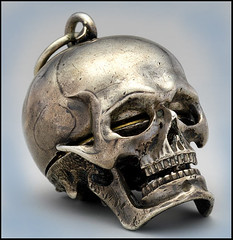
Germany and Switzerland became important watch making centers, although France also began to make watches along with England. The Swiss watchmakers seemed to have a propensity for unusual shaped cases such as Isaac Pernard and apprentice to Jacques Sermand, both known for their skull watches in the 1600s.
By the Victorian Era there was a new vogue for the outrageous and the antique. Watch makers in the middle and late 19th century made skull watches for wealthy collectors, but with fully modern (by the standards of the day) movements. The rising middle class of the Industrial Era saw more people with more disposable income and lesser expensive skull watches were collected by the well to do.
This 18k gold skull watch dates to 1810 and had diamonds for teeth and eyes. The enameled skull opens up to reveal the watch face and there is a small glass port under the skull to watch the movement operate. This watch sold recently for $18,000.
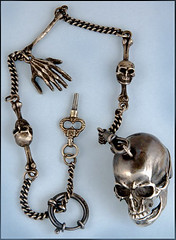 By the early 20th century, old world watchmakers were making copies of skull watches for collectors. Even now, there are a few watch makers producing quality sterling skull watches such as the one to the right vs the plethora of cheap Chinese-made skull watches out of plated base material and quartz movements.
By the early 20th century, old world watchmakers were making copies of skull watches for collectors. Even now, there are a few watch makers producing quality sterling skull watches such as the one to the right vs the plethora of cheap Chinese-made skull watches out of plated base material and quartz movements.
 By the early 20th century, old world watchmakers were making copies of skull watches for collectors. Even now, there are a few watch makers producing quality sterling skull watches such as the one to the right vs the plethora of cheap Chinese-made skull watches out of plated base material and quartz movements.
By the early 20th century, old world watchmakers were making copies of skull watches for collectors. Even now, there are a few watch makers producing quality sterling skull watches such as the one to the right vs the plethora of cheap Chinese-made skull watches out of plated base material and quartz movements.Those of you who enjoy Steampunk or a bit of Cthonian or Victorian dress up have enjoyed this two part trip into exotic time pieces and this sterling horologic cranium. I am sure all of us have wanted a goodie or two for Christmas like this. It's a no-brainer.
CoastConFan
Wednesday, November 23, 2011
Happy Thanksgiving

On Thanksgiving I shall be off to the old homestead for a dinner of turducken, which is an enigma wrapped in a mystery and covered in special conundrum sauce with a sprinkle of obscurity on top*. Served on a riddle, warm. Yum. Happy holidays to you all.
CoastConFan
*My sincerest apologies to Winston Churchill.
Sunday, November 20, 2011
SKULL WATCHES Part One
When I was a youngster in the 1960s, two watches I really wanted to see or own were the so-called Nuremburg Egg (actually a misnomer) and the Seaton Watch (see below). The Nuremburg Egg was the earliest portable clocks made. Along side that, I wanted a skull watch. Not just any Victorian skull watch, which are expensive but available, I wanted the Seaton Watch. I always set my sights high.
The Seaton Watch was made for Mary Queen of Scots in the late 1500s by Moyant A. Bolis circa the late 1500s and given by the Queen to Mary to Mary Setoun, one of her Maids of Honor. It wasn’t actually made to be worn around the neck, being fairly heavy, but was fully portable and could be suspended by the chain on a table, prie-dieu or altar. It also has a leather form-fitting case to cover the watch when not in use.
The silver skull watch was a memento mori to remind the viewer of the transient nature of Earthy time. The watch had only an hour hand and could be viewed by opening the jaw, which exposed the face of the watch. The time was marked audibly by a small bell, which was struck on the hour. The best overall write-up of this rare watch was in Godey’s Lady’s Book, March 1850, which was a major woman’s fashion book of the era. Rather than rehash the very detailed description from a difficult to find, 160 year old source, I have simply placed it on the blog:
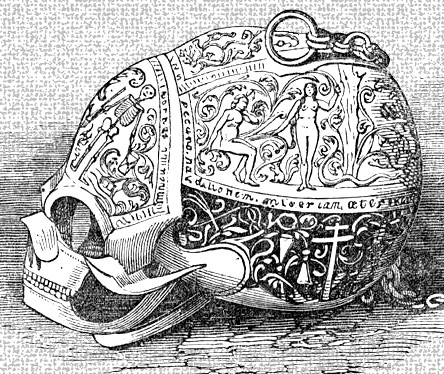
"On the forehead of the skull is the figure of Death, with his scythe and sand-glass. He stands between a palace on one hand and a cottage on the other, with his toes applied equally to the door of each; and around this is the legend from Horace, 'Pallida mors aequo pulsat pede pauperum tabernas Regumque turres.' On the opposite, or posterior part of the skull, is a representation of Time devouring all things. He also has a scythe: and near him is the serpent with its tail in its mouth, being an emblem of eternity. This is surrounded by another legend from Horace – ' Tempus edax rerum tuque invidiosa vetustas.' The upper part of the skull is divided into two compartments: on one are represented our first parents in the Garden of Eden, attended by some of the animals, with the motto, ' Peccando perditionem miseriam aeternam posteris meruere.' The opposite compartment is filled with the subject of the salvation of lost man by the crucifixion of our Saviour, who is represented as suffering between the two thieves, whilst the Marys are in adoration below: the motto to this is ' Sic justitiae satisfecit, mortem superavit, salutem comparavit.' Running below these compartments, on both sides, there is an open-work of about an inch in width, to permit the sound to come more fully when the watch strikes. This is formed of emblems belonging to the crucifixion – scourges, of various kinds; ,:words; the flagon and cup of the eucharist; the cross; pincers; lantern used in the garden; spears, of different kinds, and one with the sponge on its point; thongs; ladder; the coat without a seam, and the dice that were thrown for it; the hammer and nails, and the crown of thorns. Under all these is the motto, 'Scala caeli ad gloriam via.'

"The watch is opened by reversing the skull, and placing the upper part of it in the hollow of the hand, and then lifting the under jaw, which rises on a hinge. Inside, on the plate, which may thus be called the lid, is a representation of the Holy Family in the stable, with the infant Jesus laid in the manger, and angels ministering to him; in the upper part, an angel is seen descending, with a scroll, on which is written ' Gloria excelsis Deo, et in terra, pax, hominibus bona volu.' In the distance are the shepherds, with their flocks; and one of the men is in the act of performing on a cornemuse.
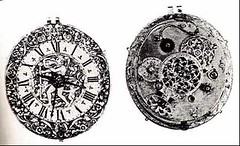 The works of the watch occupy the position of the brains in the skull itself; the dial-plate being on a flat where the roof of the mouth and the parts behind it, under the base of the brain, are to be found in the real subject. The dial-plate is of silver, and is fixed within a golden circle, richly carved in a scroll pattern. The hours are marked in large Roman letters; and within them is the figure of Saturn devouring his children, with this relative legend round the outer rim of the flat, ' Sicut meis sic et omnibus idem.' Lifting up the body of the works on the hinges by which they are attached, they are found to be wonderfully entire. There is no date; but the maker's name, with the place of manufacture, ' Moyse, Blois,' are distinctly engraven. Blois is the place where it is believed that. watches were first made; and this suggests the probability of the opinion that the watch was expressly ordered by Queen Mary, at Blois, when she went there with her husband, the dauphin, previous to his death.
The works of the watch occupy the position of the brains in the skull itself; the dial-plate being on a flat where the roof of the mouth and the parts behind it, under the base of the brain, are to be found in the real subject. The dial-plate is of silver, and is fixed within a golden circle, richly carved in a scroll pattern. The hours are marked in large Roman letters; and within them is the figure of Saturn devouring his children, with this relative legend round the outer rim of the flat, ' Sicut meis sic et omnibus idem.' Lifting up the body of the works on the hinges by which they are attached, they are found to be wonderfully entire. There is no date; but the maker's name, with the place of manufacture, ' Moyse, Blois,' are distinctly engraven. Blois is the place where it is believed that. watches were first made; and this suggests the probability of the opinion that the watch was expressly ordered by Queen Mary, at Blois, when she went there with her husband, the dauphin, previous to his death. The watch appears to have been originally constructed with catgut, instead of chain, which it now has, which must have been a more modern addition. It is now in perfect order, and performs wonderfully well, though it requires to be wound up within twenty-six hours to keep it going with tolerable accuracy. A large silver bell, of very musical sound, fills the entire hollow of the. skull, and receives the works within it when the watch is shut. A small hammer, set in motion by a separate escapement, strikes the hours on it.

"This very curious relic must have then intended to occupy a stationary place on a prie-dieu, or small altar, in a private oratory; for its weight is much too great to have admitted of its being carried in any way attached to the person."
“This watch is in the possession of Sir T. D. Lauder family, of Grange and Fountain Hall, Bart, who inherited it through the Setoun family, from which they are descended; it having been given by Queen Mary to Mary Setoun, of the house of Wintoun, one of the four Marys, Maids of Honor to the Scottish Queen.”
UPDATE: This homological wonder has been traveling throughout the world visiting such museums as the Taft Museum of Art, The Walters Museum, Munson-Williams-Proctor Arts Institute, and the British Museum. I don’t know its present whereabouts, however.
Sadly, the original movement has been modified some 250 plus years ago with the added minute hand, however the face is original in this 400 year old watch. I never got a Nuremburg Egg nor the Seaton Watch, but I’m not giving up hope.
You can download a copyright free edition of Smith’s Historical and Literary Curiosities here. Although skull watches are not part of H. P. Lovecraft’s Cthulhu Mythos, they are a great prop for the RPG. Stay tuned for the second part of Skull Watches, which I will post later on. This would also be great for Steampunk and other gamer's resources.
Labels:
CoastConFan,
Mary Queen of Scots,
Seton Watch,
Skull Watch,
Steampunk
Wednesday, November 9, 2011
Sneaky Guns III: Small and Sneaky Derringers
They may be small and sneaky, but they bite.
When you think of small, sneaky guns you think of derringers generally. They are compact, concealable, but deadly. The genre of diminutive handguns is named after a rather latecomer in the sneaky gun business. Henry Deringer produced single shot flintlock and later, percussion pistols from the middle 1820s to the Civil War. The name and guns of Deringer were imitated by copycats and a whole grouping of compact guns became known as derringers by collectors down to the present day.*
The need for practical small pocket pistols was met with flintlock pistols, sometimes called gentleman’s pistols and could be carried in the capacious pockets of men’s clothing from the 1720s onward. One of the most popular was a tiny copy of a “Queen Anne” pistol. These had screw off barrels that allowed loading from the breech and generally had no integral ramrod.
These small guns meant for a single shot with little capability of hasty reload. The only alternative was to make guns with multiple barrels such as a double barrel pistol much like a shotgun or a pepperbox style gun. Percussion guns allowed small copies of full size revolvers but in a tiny caliber such as the Remington-Rider Pocket pistol.
The short barrels of derringers precluded accuracy beyond the distance of a card table and heavy black powder loads couldn’t fully burn completely. They compensated by having a larger caliber than you would expect in such small gun, trading off mass of projectile vs speed of projectile.
Metallic cartridges, starting with pinfires and later with the venerable .22 rimfire (1857) opened up the possibility of rapid reloading. You could make small rimfires and that functioned like full-sized guns. The downside is that the caliber was also reduced. The post-Civil War era opened up to a bewildering variety of derringers and mechanisms. The uniting feature was their small, concealable size.
After the original Deringer, the Remington Double Derringer is the most recognizable with its double barrel. Over 150,000 were made from 1966 to 1935 in .41 caliber short. Interestingly Remington also made the Remington Zig-Zag Derringer, Remington Vest Pocket Pistol as well as some very small solid frame revolvers that are nearly derringer sized.
Other companies designed derringers or bought up patents to make them. For example the Moore’s #1 (1860 to 1865), later became National (1865 to 1870). Colt bought the design and made them as the Colt derringer from 1870 to 1890. This gun also could be turned around and used as a small knuckle duster (double sneaky). Also check out the William W. Marston three-barrel derringer, one model had a snap out minibayonet (sneakier yet).
By the 1880s small copies of full-sized pistols began to supplant derringers. Many were cheaply made and collectors often called “Suicide Specials” due to their cheap manufacture. With few gun purchasing laws, inexpensive and badly made guns could be bought for a dollar and change over the counter and by mail.
By the early 20th century, highly compact automatics in .22 and .25 pretty much ended the rule of derringers. They were not only small, but very quick to reload and much more rapid fire.
In my opinion, the ultimate modern 20th century sneaky gun is the Walter PPK introduced in 1931 and you just can’t beat the styling. This ends my sneaky gun trilogy post. See my other Sneaky Gun posts previously: Sneaky Guns I: GunCanes and Sneaky Guns Part II - Combinations
*note that original Deringers have one r and the generic name for the group is lower case with two r's.
Labels:
Call of Cthulhu,
CoastConFan,
Derringer,
Sneaky,
Steampunk,
Victorian Guns
Subscribe to:
Posts (Atom)





